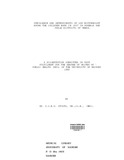| dc.contributor.author | Otiato, P S B O | |
| dc.date.accessioned | 2013-05-23T09:32:49Z | |
| dc.date.available | 2013-05-23T09:32:49Z | |
| dc.date.issued | 1990 | |
| dc.identifier.citation | Degree of Master of Public Health (M.P.H.) of the University of Nairobi | en |
| dc.identifier.uri | http://erepository.uonbi.ac.ke:8080/xmlui/handle/11295/24768 | |
| dc.description | A dissertation submitted in partial fulfillment
for the award of the Degree of Master of Public Health (M.P.H)
of the University of Nairobi | en |
| dc.description.abstract | Low birth weight is a major associated cause of perinatal and
infant mortality, and young childhood morbidity. Several
studies/surveys show that LBW is a major problem in many Kenyan
rural districts. Kwale district is among the top 10 with respect
to LBW in Kenya. This district l'I8.S found to have a childhood
mortality of 200 per 1,000 births by a UNICEF study in 1987.
The present study was cafried out in 1988, using medical
records for the calendar year 1887, with the following aims:
1. To determine the prevalence of LBW in the neighbouring
districts of ~fombasa and Kwa Le , on the Kenyan Coast, and its
relation to rainfall and malaria infection.
2. To identify,' using a case control methodology, some of the
factors that contribute to low birth weight. Knowledge of such
factors will facilitate possible interventions through exi st.Lng
MCH-FP programm~s.
3. The outcome of pregnancy in these districts in relation to the
determinants of LBW, and other maternal and obstetric factors.
The records of all documented births in 1987 kept in health
xii
facilities in Mombasa and Kwale were used to extract the relevant
information for the prevalence study.
Maternity files from two hospitals in Kwale District and Lady
Grigg Maternity in Mombasa were used to identify cases of LBW and
their controls from these institutions. These files provided the
information on contributory factors to LBW in the districts under
study.
Climatic conditions during the year were obtained from records
at the Meteorological DepartDe~t headquarters in Nairobi. Records
of malaria parasitaemia for Mombasa and Kinango were o~tained from
DVBD section of t.he National Public Health Laboratory Services
offices in Nairobi for the year 1987.
The study showed that the prevalence of LBW in 1987 was 14.1%
1n Mombasa and 22.5% in Kwale. There was a peak LBW period during
the third quarter of the year (July-September) in brith districts;
a time lag of 2-3 months existed between rainfall and LBW in both
areas.
The important risk factors associated with LBW in the two
districts were identified using logistic regression analysis. They
were: gestation of 36 weeks or less; maternal anaemia; malaria
infection during pregnancy; primigravid pregnancy; female sex;
maternal age at or below 17 years; Nombasa District delivery,
The outcome of pregnancy was found to be worse in Kwale tha.
in Mombasa for both cases and controls. The possible reasons fo
this are discussed. | en |
| dc.language.iso | en | en |
| dc.publisher | University of Nairobi | en |
| dc.title | Prevalence and determinants of low birthweight among the children born in 1987 in Mombasa and Khale Districts of Kenya | en |
| dc.type | Thesis | en |
| dc.description.department | a
Department of Psychiatry, University of Nairobi, ; bDepartment of Mental Health, School of Medicine,
Moi University, Eldoret, Kenya | |
| local.publisher | College of Health Sciences | en |

